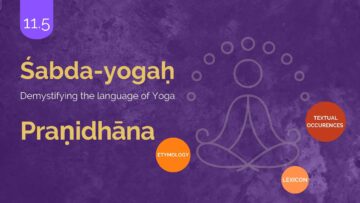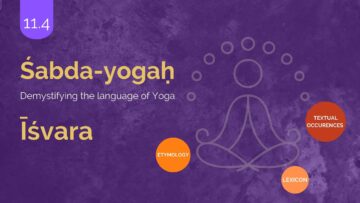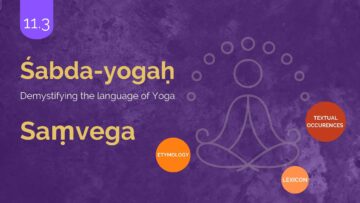Introduction
In this series, Yogic terminologies will be taken up and their –
- Etymological analysis,
- Lexical descriptions and
- Textual occurrences in Yogic literature and their commentaries, as available, will be presented. And finally observations will be made on the references.
Three texts – Yogasūtra, Haṭha-yoga-pradīpikā and Bhagavad-gītā are consulted for textual occurrences portion.
Śabda-yoga is intended to help students, teachers, and professionals of Yoga to develop a sound grammatical, contextual, and thereby an authentic and immersive understanding of Yoga terminologies.
List of Words
The words that appear in the Yogasūtras will be sequentially dealt initially and then terms from other prominent Yoga texts will be taken up. This śabda-yoga article will analyze four terms. The four terms for this article are –
- pratyakṣa
- anumāna
- āgama
- mithyā
1. Pratyakṣa
Etymology
अक्षम् + प्रति = प्रत्यक्षम्
akṣam + prati =pratyakṣam
The dictionary śabdārthakaustubha[1]to gives the following derivative
प्रतिगतम्अक्षम्इन्द्रियंयत्र– pratigatamakṣamindriyaṃyatra – that (knowledge) in which –
- the sense organ (akṣa)
- is in contact (pratigata) (with the object)
This is stated as aprādi-samās (compound) based on the vārtika- अत्यादयःक्रान्ताद्यर्थेatyādayaḥkrāntādyarthe – to the grammatical rule कुगतिप्रादयःkugatiprādayaḥ (aṣṭādhyāyī2.2.18).
Lexicon
There is one entry in the Amarakośa on this term
प्रत्यक्षंस्यादैन्द्रियकम्… (3.1.79)
pratyakṣaṃsyādaindriyakam…
Pratyakṣa refers to knowledge generated through the senses (through object contact)
This lexical entry is quite in line with the etymological derivation.
Textual occurrences
Yogasūtra
There is just one occurrence of this term
प्रत्यक्षानुमानागमाःप्रमाणानि॥१.७॥
pratyakṣānumānāgamāḥpramāṇāni॥1.7॥
Among the five activities of the mind pramāṇa (right knowledge) – right knowledge is one and pratyakṣa (direct perception through the senses) is counted as one among the sources of correct knowledge as indicated by the Sūtra.
Bhagavadgītā
There is just one reference to pratyakṣa in this text. It is found in the 9th chapter. It is as follows –
राजविद्याराजगुह्यंपवित्रमिदमुत्तमम्।
प्रत्यक्षावगमंधर्म्यंसुसुखंकर्तुमव्ययम्॥९.२॥
rājavidyārājaguhyaṃpavitramidamuttamam.
pratyakṣāvagamaṃdharmyaṃsusukhaṃkartumavyayam .. 9.2 ..
Rājavidyā is praised in this verse. Rājavidyā is the knowledge about the Brahman according to the commentary of śrīśaṅkarabhagavatpāda[2]. Rājavidyā is praised as pratyakṣāvagamaṃ – directly experienced. It is not something which is abstract and to be inferred.
Haṭhayogapradīpikā– The word pratyakṣa is not found in this text
Observations
It becomes evident based on the references above that among the Yoga texts – that in Haṭhayogapradīpikā, there is no discussion on epistemology. This seems to be true in the case of Bhagavadgītā also, where only a passing mention of the term pratyakṣa is found. Even in yogasūtra the epistemological discussions are minimal and restricted to only one Sūtra quoted above.
2. Anumāna
Etymology
अनु + मा+ ल्युट् = अनुमानम्
anu + mā+ lyuṭ =anumānam
- Anuis the prefix – which means follows
- Māis the root (माङ्माने) – to measure
- Lyut is the suffix that is used in the sense to indicate instrumentality – it is based on the grammar rule karaṇādhikaraṇāyośca(aṣṭādhyāyī3.117)
The derivative statement is – अनुमीयतेअनेनइतिअनुमानम्- anumīyateanenaitianumānam that (process) by which inference is done.
To explain – The process of inference is instrumental (lyut) in knowing (Mā – to measure) about an object that follows (anu) sensory input and the grasp of concomitance of the major and minor terms. Hence it is called as Anumāna.
Lexicon– There is no reference to this term in Amarakośa
Textual occurrences
Yogasūtra
There are two occurrences of this term in this text and both are from the first chapter.
- प्रत्यक्षानुमानागमाःप्रमाणानि॥१.७॥ pratyakṣānumānāgamāḥpramāṇāni .. 7 .. –Here inference or anumāna is counted as one among the three modes of right knowledge
- श्रुतानुमानप्रज्ञाभ्यामन्यविषयाविशेषार्थत्वात्॥१.४९॥śrutānumānaprajñābhyāmanyaviṣayāviśeṣārthatvāt .. 1.49.. – The second occurrence of term is in the context of stating that ṛtambharāprajñā(the truth bearing clarity that arises out of samādhi) is different from the clarity arising out of verbal testimony and inference.
Bhagavadgītā & Haṭhayogapradīpikā– The word is not used in these two texts.
Observations
As stated earlier – it becomes evident that Yoga texts do not have much epistemological discussions. It is also interesting to note that while inference is accepted as a valid source of authentic knowledge – there is higher state of clarity in Yogic tradition than that of inference. This also shows the relative position of inference in Yogic context.
3. Āgama
Etymology
आ+गम्+घञ्= आगमः
ā+gam+ghañ = āgamaḥ
- ā is the prefix – here this prefix is used in sense of indicating towards oneself (आभिमुख्ये)[3]
- gam is the root that means (गम्गतौ ) – to go
- ghañ is the suffix that is used to indicate instrumental case according to the grammatical rule – हलश्च halaśca(aṣṭādhyāyī3.3.121)
The derivative statement would be – आगम्यतेअनेनइतिआगमः –āgamyateanenaitiāgamaḥ -that by which (knowledge) is attained (knowledge arrives towards oneself). Though this is the derivation, conventionallyit is used to indicate authentic knowledge attained through verbal testimony.
Lexicon– There is no reference to this word in the Amarakośa
Textual occurrences
Yogasūtra
There is just one occurrence to this term in this text.
प्रत्यक्षानुमानागमाःप्रमाणानि॥१.७॥
pratyakṣānumānāgamāḥpramāṇāni .. 1.7 ..
As described earlier, through this sutra – verbal testimony is considered as one among the three modes of valid knowledge in the system of Yoga.
Bhagavadgītā
There are three occurrences of the term āgamā in this text. Though the word exists, as would be evident from references below – it is not used in the sense of verbal testimony.
- मात्रास्पर्शास्तुकौन्तेयशीतोष्णसुखदुःखदाः। आगमापायिनोऽनित्यास्तांस्तितिक्षस्वभारत॥२.१४॥ mātrāsparśāstukaunteyaśītoṣṇasukhaduḥkhadāḥ . āgamāpāyino’nityāstāṃstitikṣasvabhārata .. 2.14 ..
- अव्यक्ताद्व्यक्तयःसर्वाःप्रभवन्त्यहरागमे। रात्र्यागमेप्रलीयन्तेतत्रैवाव्यक्तसंज्ञके॥८.१८॥ avyaktādvyaktayaḥsarvāḥprabhavantyaharāgame . rātryāgamepralīyantetatraivāvyaktasaṃjñake .. 8.18 ..
- भूतग्रामःसएवायंभूत्वाभूत्वाप्रलीयते। रात्र्यागमेऽवशःपार्थप्रभवत्यहरागमे॥८.१९॥ bhūtagrāmaḥsaevāyaṃbhūtvābhūtvāpralīyate . rātryāgame‘vaśaḥpārthaprabhavatyaharāgame .. 8.19 ..
In all the three occasions the word āgama is used to indicate arrival.
In the first Gītā instance above (2.14) the sense-object contact is stated as āgamāpāyi – that which comes/experienced and perishes (transient).
In the next two references from chapter 8 (verses 18 & 19) – the process of cosmic creation and dissolution is described. In the both the verses, we find the expression rātryāgame – when the night time of Brahman comes all the beings get dissolved. The duration of day time and night time of the Brahman is indicated in verse 8.17 – as thousand Yugas each (one yuga here refers to one catur-yuga (64, 80,000 years) – commentary on the Gītāby Srīdharasvāmī[4]).
Haṭhayogapradīpikā
There are two occurrences of the word āgamā in this text. Here also the two occurrences do not indicate the meaning verbal testimony. As can be seen below – in the first occasion – āgama – refers to mere coming, in the second occasions it refers to a class of literature. The details in that regard are as follows –
- व्याधीनांहरणंजरान्तकरणंशस्त्रागमोदीरणम् तस्यस्यादमरत्वमष्टगुणितंसिद्धाङ्गनाकर्षणम्॥३.५०॥vyādhīnāṃharaṇaṃjarāntakaraṇaṃśastrāgamodīraṇam tasyasyādamaratvamaṣṭaguṇitaṃsiddhāṅganākarṣaṇam .. 3.50 .. In this first instance the compound term śastrāgamodīraṇam is found where the word āgama is used. The verse describes the benefits of the practice of khecarīmudrā. Here according the jyotsnā commentary[5]the expression indicates that – the practice of khecarīmudrā helps in warding (udīraṇam) of the weapons (śastra) that his coming towards (āgama) oneself (being hurled by the enemies). Thus the word āgama is not used in the sense of verbal testimony.
- केचिदागमजालेनकेचिन्निगमसङ्कुलैः। केचित्तर्केणमुह्यन्तिनैवजानन्तितारकम्॥४.४०॥ kecidāgamajālenakecinnigamasaṅkulaiḥ . kecittarkeṇamuhyantinaivajānantitārakam .. 4.40 ..
This is a verse that speaks of- people being distracted by the promises of material benefits made in the Āgamas and the Nigamas and they do not know about the ways to cross sufferings (through Yogic practices). The Jyotsna commentary here defines agama as[6]– those that arrive and ascend the intellect (to clarify various practices and truths) –- the śāstras and Tantras.
Observations
In conclusion it can be stated that the word Āgama has been used in diverse sense in the Yoga texts consulted –
- Verbal testimony (yogasūtra)
- Arrival (bhagavadgītā & haṭhayogapradīpikā)
- Śāstras & Tantras (haṭhayogapradīpikā))
Hence one needs to be context conscious in using the terminology even for Yogic purposes.
4. Mithyā
Etymology
मथ+यक्= मिथ्या
matha+kyap = mithyā
- Matha is the root (मथविलोडने) – to aGītāte, to shake, to stir
- Yak is the suffix which is used to indicate – the doer. This suffix is added based on the grammatical rule अघ्न्यादयश्च aghnyādayaśca (uṇādisūtram4.112)
The derivative statement is मथतेइतिमिथ्या[7]–mathateitimithyā- That which aGītātes, shakes and stirs.
Conventionally Mithyā in the texts refer to something which is wrong/false. Indeed, going by etymology falsehood – aGītātes, shakes and stirs.
Lexicon
The solitary Amarakośa reference on the term is as follows –
मृषामिथ्याचवितथे (3.4.15)
mṛṣāmithyā ca vitathe
mṛṣāmithyā and vitathe point to falsehood
Textual occurrences
Yogasūtra
There is just one reference to mithya in this text. It is as follows –
- विपर्ययोमिथ्याज्ञानमतद्रूपप्रतिष्ठम्॥१.८॥ viparyayomithyājñānamatadrūpapratiṣṭham .. 1.8 ..
As evident from the reference Viparyaya –activity of the mind is defined as false/wrong knowledge (mithyā-jñāna) which not based on the form/attribute of the object that is being perceived/known.
Bhagavadgītā
In this text also there is a solitary reference. It is in the context of Karma-yoga. Here also the term mithya is part of a compound – mithyācāra –
- कर्मेन्द्रियाणिसंयम्ययआस्तेमनसास्मरन्। इन्द्रियार्थान्विमूढात्मामिथ्याचारःसउच्यते॥३.६॥ karmendriyāṇisaṃyamyayaāstemanasāsmaran . indriyārthānvimūḍhātmāmithyācāraḥsaucyate ..3.6..
As evident from the reference – Even while not employing the senses of actions, but remembering the objects of the senses in the mind is called as Mithyācāra -false practice or hypocrisy. Lord Kṛṣṇa states this to emphasize that this is not the way to do Karmayoga.
Haṭhayogapradīpikā
There is just again one reference in this text for mithyā. It is again part of the compound mithyāpralāpa. The reference in that regard is as follows –
- यावन्नैवप्रविशतिचरन्मारुतोमध्यमार्गे यावद्बिन्दुर्नभवतिदृढःप्राणवातप्रबन्धात्। यावद्ध्यानेसहजसदृशंजायतेनैवतत्त्वम् तावज्ज्ञानंवदतितदिदंदम्भमिथ्याप्रलापः॥४.११४॥ yāvannaivapraviśaticaranmārutomadhyamārge yāvadbindurnabhavatidṛḍhaḥprāṇavātaprabandhāt . yāvaddhyānesahajasadṛśaṃjāyatenaivatattvam tāvajjñānaṃvadatitadidaṃdambhamithyāpralāpaḥ .. 4.114 ..
This is the very last verse of the text. It is indicated here that – without making the Prāṇa move in Suṣumnā, without making the semen firm (control over sensual attractions), without attaining the state resembling Sahaja (Samādhi) – merely speaking about the knowledge (of Yoga) is boastful, false prattle (mithyāpralāpa).
Observations
In conclusion it can be stated that mithyā, meaning false/wrong – is used an adjective in the yogic texts considered here – falsehood in knowledge, practice and prattle (mithyājñāna, mithyācāra, mithyāpralāpa). Unlike in Vedānta it is not used to indicate illusionary or false nature of the entire creation (jaganmithyā).
To be continued…
[1]Śabdārthakaustubha, Vol 4, pg.1892
[2]राजविद्याविद्यानांराजा, दीप्त्यतिशयवत्त्वात् ; दीप्यतेहिइयम्अतिशयेनब्रह्मविद्यासर्वविद्यानाम् – https://advaitasharada.sringeri.net/display/bhashya/Gita#BG_C09
[3]avyayakośaḥ, pg.80
[4]युगशब्देनात्र चतुर्युगमभिप्रेतम्चतुर्युगसहस्रं तु ब्रह्मणो दिनमुच्यते इति विष्णुपुराणोक्तेः। (https://www.gitasupersite.iitk.ac.in/srimad?language=dv&field_chapter_value=8&field_nsutra_value=17&scmad=1&scsri=1&ecsiva=1&etadi=1 )
[5]शस्त्राणामायुधानामागमः स्वाभिमुखागमनं तस्य उदीरणं निवारणम्
[6]आगच्छन्ति बुद्धिमारोहन्ति अर्था एभ्यः इत्यागमाः शास्त्रतन्त्रादयः
[7]शब्दकल्पद्रुम – śabdakalpadrumahttps://kosha.sanskrit.today/word/sa/mithyA?q=%E0%A4%AE%E0%A4%BF%E0%A4%A5%E0%A5%8D%E0%A4%AF%E0%A4%BE
Image Credit: istockphoto.com
Disclaimer: The opinions expressed in this article belong to the author. Indic Today is neither responsible nor liable for the accuracy, completeness, suitability, or validity of any information in the article.










